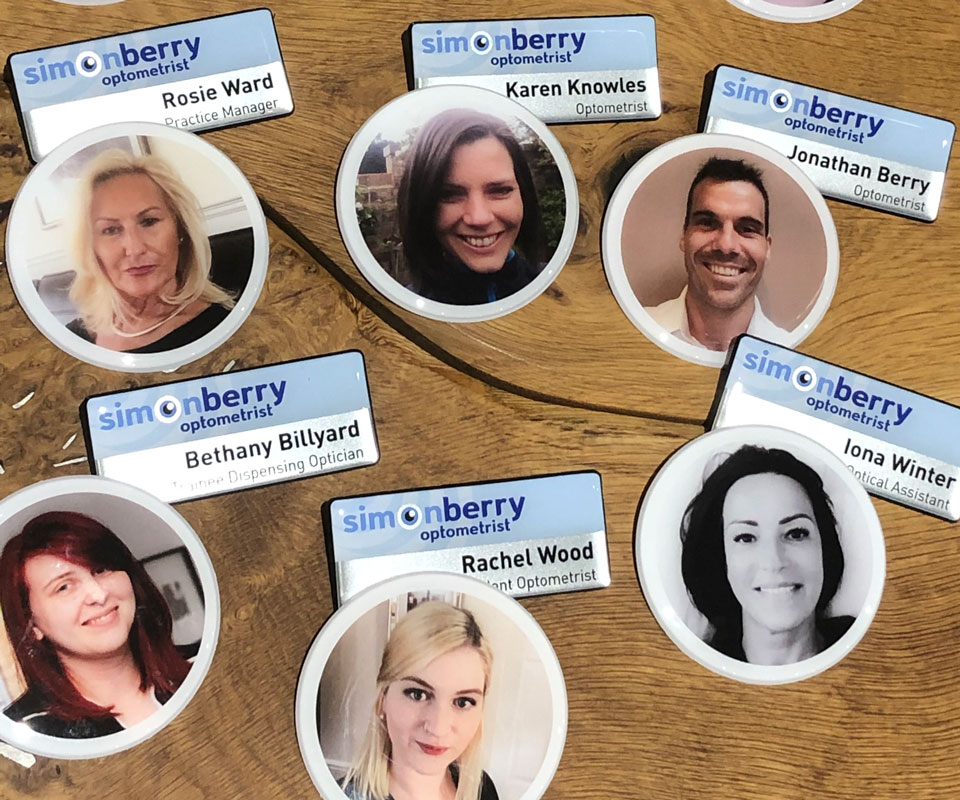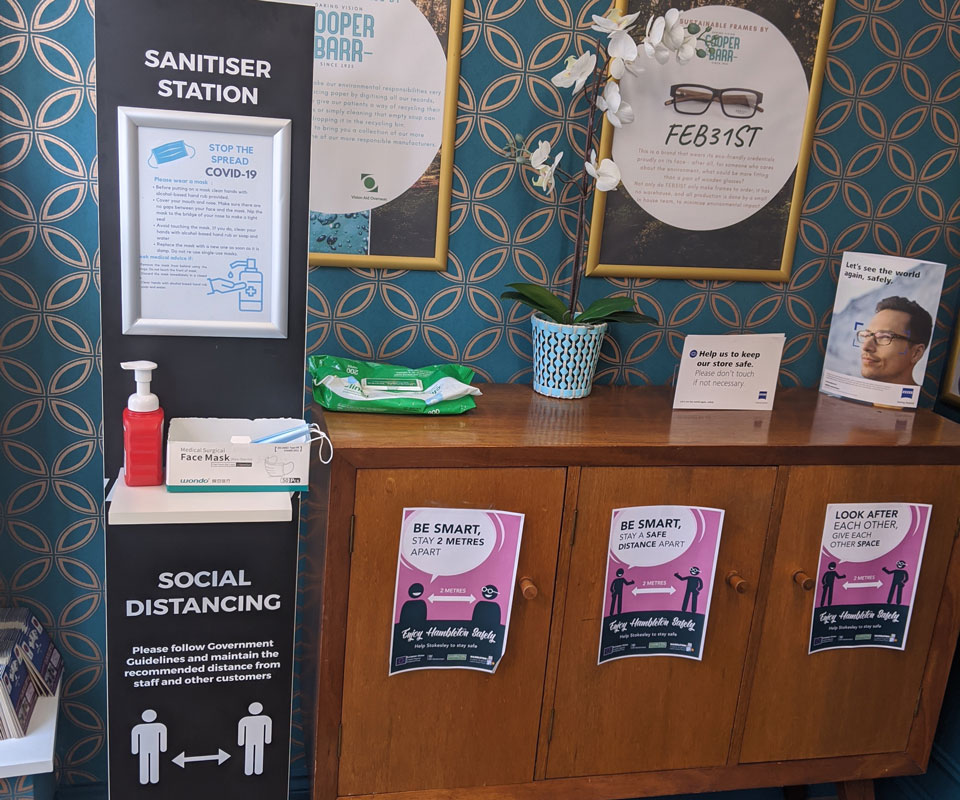- OT
- Life in practice
- Business management
- Changes to practice: “Every part of the patient journey has been adjusted”
Changes to practice: “Every part of the patient journey has been adjusted”
From Perspex screens and hand sanitiser, to video explainers and smiley badges, these are some of the ways practice owners are adapting

29 June 2020
As lockdown restrictions have been gradually lifted in the UK, practice owners have been making changes in order to safely accommodate patients and prepare for the return to routine care.
With the need to maintain social distancing where possible and minimise contact for the safety of staff and patients, the practice setting is going to look different for many as optometrists begin to move into a ‘new normal’.
A survey by the Hakim Group of over 900 respondents last month found safety was the top priority for practices, with measures taken including sanitising equipment (79.2%), infection control (75.8%) and adding protective furnishings (38.2%).
The practice environment looks different for Nicola Gatehouse, director of Ball & Gatehouse Opticians in Wirral. She has installed plastic screens in reception, and sourced hand sanitiser, mediwipes and a large stock of PPE.
The practice has also purchased a UV sanitiser. She explained: “We’re not allowing patients to try on any frames; they’ll have to point out which ones they want and what they try on goes into a tray to get sanitised afterwards.
The practice will also continue to operate behind a locked door and through appointments only.
The fabric waiting room chairs – which had been new in the spring – have been replaced with plastic and wipeable seats. The waiting area itself has been changed so there is only one chair in the waiting area, and one in the dispense.
“I’ve been doing this job nearly 25 years, and I feel like I’ve gone back to the beginning again because I have to think about everything I do,” Ms Gatehouse observed of the changes. “It really takes it out of you.”
When it comes to delivering care, patients will receive a phone call from the optometrist in the morning for their history and symptoms, reducing face to face contact when they are in the practice.
Ms Gatehouse explained the practice would not be in “any rush” to move too quickly as the suspension on routine eye care was lifted.
Like many, the practice initially found sourcing PPE a challenge as the supply chains struggled with the high demand. With eyewear brands now launching their own lines, the availability seems to be growing.
“Going forward I think the challenge is going to be the General Ophthalmic Services (GOS) fee,” Ms Gatehouse explained. “Even at the minute, we’re doing a 40-minute test and we’re only getting £21.32 for an NHS test. If I have to factor in PPE and a longer test time, I don’t know how that’s going to work with the GOS system as it stands.”
She continued: “We haven’t put the prices up as yet and we’re going to absorb that cost to start with. I think the masks work out to about 50p each, but then you have all the cleaning products as well and the aprons, which are worn per-patient. The busier you get, the more the PPE costs you.”
“These are certainly unprecedented times and I do think that our industry is going to be fundamentally changed by the time spent in lockdown,” optometrist and practice owner, Simon Berry, tells OT.

Mr Berry agrees the way the industry is funded needs to change, commenting: “If optometric practice as we know it is to survive then it must be viable to run a business on the skill of the clinician rather than the whim of a consumer.”
Mr Berry argues that “routine” has taken on a “completely different meaning”, explaining that every decision regarding a patient is now caveated with the risk-balance of potentially spreading the virus.
“In some ways, the preparation for opening is very simple - disinfect everything thoroughly, minimise patient contact, aim to ensure that staff and patients stay 2 metres away from each other, and when this can’t happen make sure that the appropriate PPE is worn,” Mr Berry suggested, but added: “Of course in reality, it is a nightmare of logistics and every adjustment carries with it additional cost. The PPE alone will cost around 12% of the GOS sight test fee.”
If optometric practice as we know it is to survive then it must be viable to run a business on the skill of the clinician rather than the whim of a consumer
Within his own practice, Simon Berry Optometrist in Durham, Mr Berry said he has been making changes. He explained, “Every part of the patient journey has been adjusted to try and ensure that we are doing our best to control the risk and avoid spreading the virus.”
This includes arranging initial video assessments so optometrists can complete history and symptoms remotely, meaning the team can plan the eye test in advance, noting any additional tests that would need to be arranged.
The practice is planning to trial and organise ‘virtual’ dispensing sessions whereby a dispenser can show patients spectacle frames through a video link, and send a selection of their favourite frames to choose from.
The practice also has UV disinfection units on order for the display spectacles, and staff have completed infection control courses.
Considering how patients may react to the optometrists wearing PPE, Mr Berry said, “I am aware that clinicians wearing PPE can be quite scary for some patients.”
“We specialise in seeing children and patients with a learning disability, so for these patients in particular an eye test with PPE will be daunting,” he explained. “So I have printed large badges for all my staff with their smiling faces on. I hope this will minimise the discomfort for some patients.”

For Nicola Heenan, optometrist and owner of Cooper & Barr Opticians in Thirsk, one of the key challenges has been applying the wealth of information and guidance to her practice.
“We’ve been trying to wade through all of the information of what is advised. There has been a lot of information and it’s filtering through it all and taking what is most appropriate to our practice,” she explained.
Cooper & Barr Opticians now has sanitiser stations in place and masks available for patients to wear. Signs and screens have been put up and the practice has also managed to create a one-way system.
The practice has also had breath guards custom-made for their slit lamps from a local company, Ms Heenan said: “We had ordered some but ours have cameras on so they didn’t fit. A local company had been round the shops in the high street making Perspex screens for them so they made all the screens for us and made some to fit around the slit lamps too.”
“We’re getting our heads around how we might book people in and find out more of what they’re needing from their appointments, such as if we’re going to have to book time with just the optometrist or with the dispensing optician as well. We’re also considering how we can limit the number of people in practice while still trying to keep a bit of a flow going too,” Ms Heenan explained.
With the uncertainty early on in the lockdown and challenges sourcing PPE, Ms Heenan said she tried to order “bits here and there so we would have stuff in.” The practice has since been able to source PPE from suppliers as well as the Local Optical Committee.
“Now prices are coming back down to a slightly more reasonable level, but it is still a cost. I think, just for seeing eight patients a day with myself and two members of staff in, it probably works out at about £3 per patient cost,” Ms Heenan said. “In itself it doesn’t sound that much, but in comparison to what we get paid from the NHS, it’s a big chunk of what we have there.”
In order to explain the changes to practice so patients are prepared when they arrive, Ms Heenan has been sharing a series of videos on social media and the practice website, which have represented a step outside of her comfort zone.
“We had been talking about doing them before the lockdown on other things about the practice and I was a bit shy about putting myself forward in that way. But during lockdown, lots of companies have done different webinars and I did some social media ones with Nikon,” Ms Heenan explained. “I just had to bite the bullet as I knew this was the opportunity to do it.”
Do you feel prepared to return to a form of routine practice?
“I think we are prepared but we're going to take it slowly. I’m not going to rush in and do 15 eye tests a day. We're just happy to be open, happy to be helping people again, but still very mindful of the fact this virus hasn’t gone away. We still need to be careful and I certainly don’t want to put my staff or customers at risk, so we’ll be taking things steady to start with.”
Simon Berry
“I really have no idea. Everything I am doing is on a hunch and a prayer. I’m sure I’ve got some things wrong, but hopefully there are enough good decisions to keep us in business. Time will tell.”
Nicola Heenan
“I feel confident about returning. It’s kind of a challenge and it’s different. What this has allowed us to do is to think about doing things differently and a chance to then implement them. We have to do things differently so might as well start as we mean to go on. I feel quite positive about it.”
Advertisement


Comments (0)
You must be logged in to join the discussion. Log in